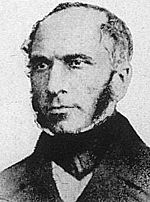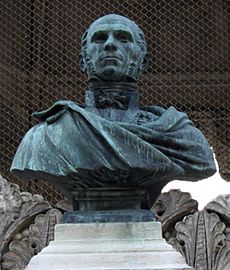Henry Darcy facts for kids
Quick facts for kids
Henry Darcy
|
|
|---|---|

Henry Darcy
|
|
| Born | 10 June 1803 |
| Died | 3 January 1858 (aged 54) Paris
|
| Nationality | French |
| Alma mater | École Polytechnique École des Ponts et Chaussées |
| Known for | Darcy's law Darcy–Weisbach equation |
| Awards | Légion d'honneur |
| Scientific career | |
| Fields | Hydraulics |
Henry Philibert Gaspard Darcy (born June 10, 1803 – died January 3, 1858) was a clever French engineer. He made big discoveries about how water moves, especially in pipes and through sand. You might know his work through things like Darcy’s law, which helps us understand how water flows underground.
Contents
Early Life and Education
Growing Up and School
Henry Darcy was born in Dijon, France, on June 10, 1803. Even though his first name was Henry, some people spelled it Henri. He always used the English spelling, Henry.
When Henry was 14, his father passed away. But his mother managed to borrow money. This helped Henry get the education he needed. In 1821, he went to the École Polytechnique in Paris. This was a famous engineering school. Two years later, he moved to the School of Bridges and Roads. This led him to work for the French government's Corps of Bridges and Roads.
In 1828, Henry Darcy married an English woman named Henriette Carey. Her family lived in Dijon.
Engineering Work and Discoveries
Building a Water System for Dijon
As an engineer, Darcy built an amazing water system for his hometown, Dijon. Before this, the city had trouble getting enough clean water. Darcy's system brought water from a spring called Rosoir. This spring was about 12.7 kilometers (nearly 8 miles) away.
The water traveled through a covered aqueduct (a special water channel). It went to large storage tanks near the city. From there, a network of 28,000 meters (about 17 miles) of pipes carried the water. This system used gravity to move the water. It didn't need any pumps. Sand was used as a natural filter to clean the water. This smart design provided clean, pressurized water to many homes in Dijon.
Improving How We Measure Water Flow
Darcy also worked on how water flows in pipes. He improved an existing formula called the Prony equation. This formula helped calculate how much energy water loses due to friction inside pipes. Later, another scientist named Julius Weisbach made more changes. Today, this improved formula is known as the Darcy–Weisbach equation. Engineers still use it to understand water flow.
In 1848, Darcy became the Chief Engineer for the area where Dijon is located. He later moved to Paris. There, he could focus more on his research about water. He studied how water flows and how friction affects it in pipes. During this time, he also made a better design for the Pitot tube. This tool is used to measure the speed of water or air. The design he created is still used today.
Darcy's Law: Understanding Water in Soil
In 1855, Darcy's health wasn't good, so he left his job. But he was allowed to keep doing his research in Dijon. In 1855 and 1856, he did important experiments. He watched water flow through a column filled with sand. These experiments led to what is now called Darcy's law.
This law helps us understand how water moves through porous materials. Porous means having tiny holes, like sand or soil. Darcy's law was first used for sand. But now, it's used for many other things. For example, it helps scientists figure out how water moves underground. The unit of measure for how easily water can flow through a material is called the darcy. It is named in his honor.
Henry Darcy sadly passed away from pneumonia in 1858. He was on a trip to Paris at the time. He is buried in Dijon.
See also
 In Spanish: Henry Darcy para niños
In Spanish: Henry Darcy para niños
- Darcy (unit)
- Darcy friction factor formulae
- Darcy number
- Hydrogeology
- Pitot tube


